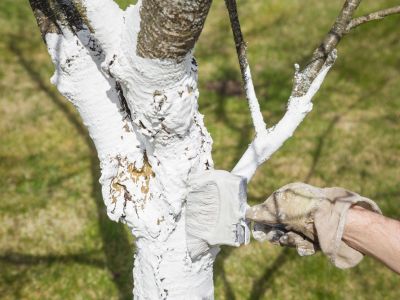Why Do People Paint Trees White?
Painting tree trunks white is a time honored method of young tree protection often found in orchards and tree farms. There are several purposes but chief among them is to prevent cracking and splitting of the tender new bark, which can allow introduction of disease, insects, and fungus. It is also helpful to highlight insect infestations and may prevent some borers. There is some debate as to the effectiveness of tree trunk painting. It certainly directs burning sun rays from the tender bark, but the wrong product can cause more harm than good.
White Tree Trunk Paint
The proper product to use for tree trunk painting is water-based latex paint. The paint needs to be diluted at a rate of one gallon latex mixed with four to five quarts of water. A Cornell University study found that a full strength application painted on protected best against borers. Another formulation is one-third each water, latex paint, and joint compound, useful for sunscald protection. Never use an oil-based paint, which will not allow the tree to respirate. If rodents such as rabbits are nibbling on your young trees, add a rodent repellent to the white tree trunk paint to prevent their gnawing damage. While some experts say to only use interior paint, others recommend the opposite. Really, as long as it’s latex paint, either should work fine. Keep in mind, however, that some paint may contain additives that can be harmful to plants, so check this beforehand. In fact, looking for one with an organic base may alleviate this concern. Also, in addition to white, you can actually use any light color paint and get the same results– just stay away from the darker tones which will absorb heat and cause further sunscald.
How to Paint Tree Bark
Once you have mixed your paint mixture, the best method of application is by paintbrush. Tests indicate that spraying doesn’t provide adequate protection and does not stick as well to the bark. One single coat is sufficient in all but the most severe conditions. Painting tree trunks white is an easy and fairly non-toxic way to protect your plant from several different problems. The process is easy, cheap, and only needs to be done once per year in extreme weather zones.
